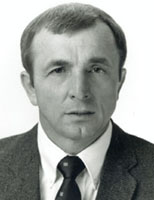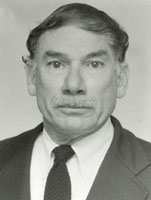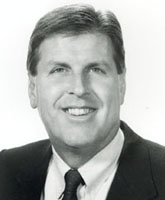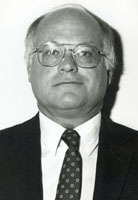 |
|||
|---|---|---|---|
 |
 |
 |
 |
| Jim Cummins Battle Creek Springfield |
Herm Kiewiet Kalamazoo Loy Norrix |
Elliott Pearce Grand Rapids Forest Hills Central |
Jim Teal Saginaw Heritage |
 |
|||
|---|---|---|---|
 |
 |
 |
 |
| Jim Cummins Battle Creek Springfield |
Herm Kiewiet Kalamazoo Loy Norrix |
Elliott Pearce Grand Rapids Forest Hills Central |
Jim Teal Saginaw Heritage |
(click on Inductee's name to read 'description')

Jim Cumrnins labeled himself a "babysitter" when he first started coaching high school tennis 20 years ago. Previous to that time, he had played 17 years of organized baseball, including one year at Central Michigan University. He had even coached a year of varsity baseball before moving to Battle Creek Springfield where the current Springfield coach got him interested in the game. Obviously a skilled athlete and experienced competitor, Jim caught on quickly, devouring books, going to clinics, and tagging along as assistant coach. Because of this hard work and dedication to a newfound love, he has become, as one local sports writer wrote ten years ago, "one of the most respected coaches in his profession."
Results of the ten years hence have done nothing but add to this assessment. Jim's devotion to our sport, his commitment to excellence, and his service to his school, community, and our association have manifested themselves in a variety of truly impressive ways. For instance, even though he presides over a small Class C-D program, he has coached 44 regional championship players with only five having taken lessons from anyone else. He has coached his teams to 11 straight league titles in a school where all achievements at the state level, too, having coached four individual state champions.
However, Jim's contributions go far beyond the success of his high school teams. For instance, he has served on the state seeding committee (an exhausting task, as some of us can testify) since it was organized. He has ten years and has been in charge of two CIass C-D state tournaments. He has organized 4 or 8 team Saturday tournaments for both boys and girls. He has spearheaded the MHSTeCA's effort to find housing for our Hall of Fame exhibit and has made arrangements for plaques, rings, and pendants since its inception. He has served as chairman currently is our president.
As impressive as these contributions are, Jim does not limit his service to the school year. During his busy career he has developed a summer camp, has run too many summer leagues and tournaments to mention here, and has served as a referee at Kalamazoo's Jr. National's for the past three years. His expertise and devotion to the game is also evident in that he has coached two sons who are currently playing college tennis on scholarships.
Behind this long and impressive list of contributions stands a genuinely warmhearted and honest individual who consistently battles for what is right rather than what is expedient. Remarks made by Jim at association meetings reveal a man who is highly principled. Those of us who have worked with him for these many years know him to be a person who lives his beliefs. Indeed, although he has described his former student and current Allegan coach, Garry Ellis, as "a man I would want my sons to play for," there are many of us with sons of our own who have occasionally wished that we had lived in the Batfie Creek Springfield School District. Jim Cummins is, in essence, an honorable man who lends grace and prestige to both our coaching profession and to our Hall of Fame.
For many years, Herm Kiewiet, the "man in the stetson," was a fixture at MHSAA final tournaments. He would arrive in Kalamazoo or Midland wearing his distinctive hat and shepherding his team in a distinctive limosine-like aerobus. More often than not, he, his hat, and the aerobus would be present on the second day of the tournament as his team collected either a state championship or runner-up trophy. In fact, during the first seven years of the team format to determine state titles, his Kalamazoo Loy Norrix Knights were either champions or runners-up an incredible six times. Indeed, his teams have established records that may never be broken.
One record that coach Kiewiet's players achieved was to become state champions during the last year of the old individual player format and also champions in the first year of the new team format. They attained the first goal in 1976 when they became the first Kalamazoo area team to win as undisputed Class A title since 1960. However, this achievement pales in comparison to what the Knights did the following year. At that first landmark tournament, coach Kiewiet's players swept 6 out of 7 flights on their way to winning 34 out of 35 points, an astonishing feat at the traditionally deep Class A level. His teams then went on to win state titles in 1979 and 1982 while finishing second in 1978 and 1981.
Throughout this success, coach Kiewiet didn't merely stand pat, toss out balls, and accept trophies. Once his teams became one of the most powerful in the state, he organized the Loy Norrix Tournament of Champions, a veritable feast of competition for which he raised money to rent court time and to provide trophies. Then he invited the strongest teams in the state, regardless of class, to Kalamazoo to participate in an event that treated spectators to better tennis than was seen at many of the state tournements. He also extended his team's level of competiton by taking them to the Detroit area, Grand Rapids, Ann Arbor, Holland, and even out-of-state where the Knights played state champions from Northern Indiana and Illinois. In the traditionally talent-rich Kalamazoo area, Herm truly "gave as good as he got."
Herm's giving also extended beyond the realm of high school tennis. His contributions included privately donating nets, tennis racquets, and balls, building a hit wall at his private residence and encouraging use of it by area youngsters, and successfully lobbying boards of education in both Kalamazoo and in his home community of Three Rivers for more tennis courts. In addition, he spearheaded the fundraising effort for resurfacing the Loy Norrix courts (it is interesting to note that he secured all funds from private and business sources). He was also involved for twenty years in the USTA National Tournament held in Kalamazoo each summer as linesman, overnight host, emergency referee, transportation provider, and "unofficial gofer" for tournament directors. Indeed, the list of such contributions goes on and on.
Another testament to Herm's effectiveness is the list of his quality players who have gone on to play major college tennis. They range from Greg Hodgeman, who played four years at the University of Iowa, to Mike Balkin, who played four years at Northwestern to John LaParl , who played four years at Michigan State. Jim Daugherty, who played for Ball State, is currently a tennis pro in Indiana while Scott Lyke, who played four years at Eastern Michigan, recently became the head coach there. What is even more impressive, perhaps, is that Herm helped coach and motivate his two sons who both became Michigan High School Class B No.1 singles champions. Dave went on to become a junior college All-American while Mike played three years of varsity tennis for Western Michigan and was the team's most valuable player all three years.
Even in retirement, Herm hasn't quit. He still encouranges elementary kids to hit against the wall at his home which has helped train so many others. Last summer, he bought balls from the National Jr. Tournament and donated them to his community. He has spent school lunch hours for the past two years providing free tennis lessons to the kids. Such actions testify that he does not dwell in the past but we hope the Hall of Fame recognition that we proudly bestow today will serve to remind him, for a few moments, and others, for generations to come, of what he has accomplished.
Elliott Pearce started playing tennis between his freshman and sophomore years in high school when he watched a father and son play. It looked like fun, so he started to learn the game and has been playing ever since. Later on, he would have the thrill of coaching the son of that son on one of his many successful tennis teams.
Indeed, Elliott has been playing and coaching tennis for more than a generation. During this time, he has experienced gradual and steady improvement both in his personal play and in his coaching efforts. Although he started to play the game relatively late by today's standards, he played varsity tennis for three years at Grand Rapids South where he was regional doubles champion in his senior year. He then went on to play varsity tennis at Ferris State for four years where he became a national qualifier during both his junior and senior years and where he won the Senior Scholastic Athletic Award. An early indication of his leadership capabilities is evidenced by the fact that he was captain of his high school team during his senior year and captain of his college team in both his junior and senior years.
When Elliott first started teaching at Forest Hills in 1966, the school did not have a tennis program, nor did it have courts. In order to start tennis there, he first had to talk the board of education into building courts, a process that has gradually and painstakingly led over the years to their present eight courts and a shed.
Elliott's program got off to a great start during those early years because the new tennis team was put into a smaller league where, in fact, it won the leatue championship that very first year. Unfortunately, this championship was not the forerunner of many to come since Elliott's school has to compete with perennial power East Grand Rapids. Nevertheless, Elliott's Rangers have provided East with some of it's most difficult matches, often upsetting the Pioneers in various flights and annually proving that they can play with the best teams in the state. Further proof comes of this every year at the final tournament to which Elliott's teams almost always qualify and where they almost always finish in the top ten. It is interesting to note that Elliott's boys and girls have never won an MHSAA regional title but have finshed second 14 times (9 for the boys and 5 for the girls). However, at the state tournament, these teams have finished in 3rd, 4th, 5th, and 6th place and his 1985 girls emerged as state runner-up.
Throughout this distinguished (but what must be frustrating) career, Elliott has gained great respect among his peers for his diligence, deportment, and integrity. He has run his own boys invitational for the past three years, has hosted three conference meets and three regional tournaments, and has even directed a girls state Class B final tournament. He has served for the first time on the boys state seed committee this past year, a task that not only requires great energy but the respect of one's peers. This respect is further exemplified in his election to the office of Second Vice-President of the MHSTeCA which means that eventually he will be our president. There is little doubt that our association will be in good hands at this time.
Elliott has been widely praised by a variety of observers. Fellow coaches admire and approve of the deportment of his players and the discipline he exerts over them. Indeed, he has not hesitated to suspend offending key players, an especially courageous thing to do given the team's often "close but no cigar" status. Bert Bleke, Elliot's former principal at Forest Hills has said "I have never seen Mr. Pearce place winning before his concern for students or before the high standards of conduct that he has expected of them and himself." This sentiment is echoed by District Athletic Director Bob Rowbotham who says that "the win/lose record is not always an indication of a sound coach. In Elliott's case, he personally has sound habits, attitudes, knowledge and educational skilIs to go along with an outstanding win-lose record."
Thus, what we see in Elliott Pearce is a winner in every sense of the word. He is the kind of person that displays the best qualities of all coaches, regardless of their sports. As such, he makes us proud to be a part of a group to which he belongs, and certainly sustains the level of achievement that marks those who are currently in the MHSTeCA Hall of Fame.
When Jim Teal looks back on his life in tennis, both as a player and as a coach, he can find himself in no fewer than 42 team pictures. Gazing at each of these pictures, he can identify every one of his 46 former teammates and over two hundred players whom he has coached. Jim has said that these pictures represent some of the fondest memories of his life.
Jim began what he calls an "instant love affair" with tennis when he played JV tennis as a sophomore at Midland High School under MHSTeCA Hall of Famer Al Buschman. He improved rapidly, played varsity the next year and No. 1 singles his senior year. Jim then went on to play three years of varsity tennis at Western Michigan University under Hap Sorensen. During this time, the team won the MAC title all three years and as a senior, Jim was elected captain of a team that won the conference championship for the tenth consecutive year.
In 1964, Jim's coaching career began at Saginaw Douglas MacArthur High School where he had an opportunity to create a new program at a new school. Predictably, the team started slowly with mostly beginning players but by the time Jim left in 1970, it had won 33 of it's last 35 dual meet matches and three straight conference titles, a worthy testament to the effectiveness of this young coach's enthusism and expertise.
During these early years, Jim was also active in tennis outside high school coaching. He ran the summer program in Saginaw Township and Midland, started the Tri-City Tennis Camp, and helped recreate the Northeastern Michigan Tennis Association, serving as rankings chairman. In 1972-77, he was deeply involved in the Can-Amera games, an Olympic-type event between Saginaw Township and Cambridge, Ontario in which Jim continued to play competitive tennis, was ranked as high as 8th in NEMTA, and was selected to play in the ceremonial first match for the dedication of the township's new tennis courts.
After a brief hiatus from high school tennis when he became tennis director of the Hoxie Tennis House in Midland, Jim returned to teaching and coaching in Saginaw and once again took charge of a new program. He coached the Eisenhower boys from 1971-80 and was the girls coach from 1972 to 1988. Although he looked forward to beating his old school and cross-town rival, his boys team never won a dual meet from MacArthur but certainly enjoyed the sweet taste of victory by winning the conference tournament in 1988. His girls team fared better, winning the conference title five consecutive years, capturing one regional title, and qualifying for the state finals five times where they finished as high as sixth.
Jim's tennis experience served him well in 1978 when he contracted a virus called Guillain-Barre while on a summer wilderness camping trek in the Upper Peninsula. The disease left him completely paralyzed for several months. He credits "patience, which I practiced as a player and preached as a coach" as one of his greatest assets during this difficult time. Getting out of the hospital just before Labor Day that year, Jim taught classes for two hours a day, went for therapy, and then coached his girls team from a wheelchair. It was a remarkable season for everyone involved in that, despite the difficult circumstances, his girls won the conference championship that year, finished second in the regional, and qualified for the state tournament. This time in Jim's life vividly illustrates not only the courage of this man but the love and commitment he has for his team and his sport.
Jim has said: "My life in tennis has been very full. It is a tremendous part of me as a person and I can only hope that I have given back to the game and the people involved just a tiny portion of what they have given me." Players, fellow-coaches, and parents with whom he has been involved would take exception to the" tiny portion " of that statement. Indeed, the fact our coaching ranks include such a knowledgeable and giving individual only serves to enhance our recognizing the many contributions he has made to his high school tennis teams and to the sport itself.